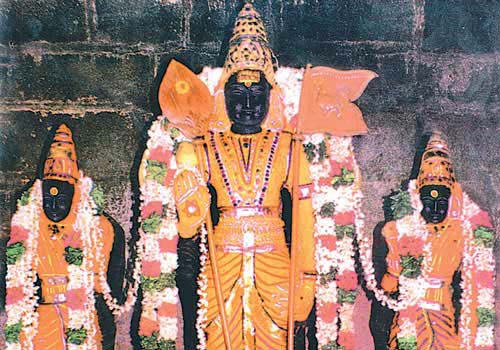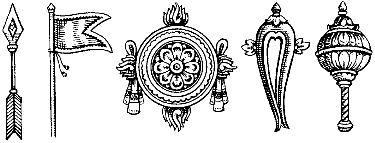
|
||||
|
| ||||
Vallakkottai Murukan TempleGiridharilal Moorchand
Right from the pre-historic time down to the present days, the Tamils had a great fascination for the worship of Lord Murukan. There is concrete evidence to show that there existed temples for Murukan in the ancient Tamilakam. Purānānuuru speaks of the Murukan kottam.[1] Kottam in Tamil means temple. There is also a clear-cut reference to Tiruchendur Lord Murukan Temple in Purānānūru[2] and Tiruchendur was denoted as Centil. In the ancient time, Ālavāi'[3] was also another name for Tiruccentur. In Akanānuuru,[4] reference is also made to Tirupparankundram Murukan temple. It is also stated in the above poem that festivals were celebrated throughout the year without any break and the people in and around Madurai city thronged to these festivals. In Tirumurukārruppatai, it is mentioned that the ancient Tamils worshipped Murukan in woods, groves, islands, rivers, tanks, cross-roads, junction, katampu trees blossoming with new flowers, and all other public places of importance.[5] It may be well assumed that the Murukan worship was prevalent in all these above places. This article attempts to present the history and present-day significance of the Murukan temple at Vallakkottai. Vallakkottai is a hamlet in Kanchipuram District, situated at a distance of twelve kilometers south of Sriperumputūr on the Sriperumputūr Cenkalpattu Road 24 kilometers from Tamparam on the Orakkalam Sriperumputūr bus route. Arunakirinātar denotes this Vallakkottai as Kōtainakar[6], Kōtappati[7], Kōtaiyampati[8], Kōtai enumpati[9], and Kōtai'[10]. Though Arunakirinātar mentioned this place by many names, it is presently popular only as Vallakkōttai. There are many interpretations available for this name; yet only one seems to be plausible. In Kanchipuram District, near Vallakkottai, there is another Murukan, ‘Tiruppati' (holy place) by name ‘Vallam'. By connecting this holy place ‘Vallam', the people of the area would have called ‘Vallakkottai' first. Afterwards it seems that this holy place would have naturally got the name of Vallakkottai. Whatever may be the origin of the name of Vallakkottai, the Murukan Temple would have been preceded by many centuries of Murukan culture and worship before the time of Arunakirinātar seven centuries ago. Arunakirinatar has glorified this temple in seven songs.[11] The sculptures, particularly the bewitching standing statues of Valli and Teyvayānai, remind us of the artistic workmanship of the Pallava era. The Pallavas erected temples for Siva and Vishnu at various places. Historical evidence is available now to show that Vallam near Kotainagar is one of them. The unique feature of the Pallava architecture is the rock-cut temples, in which brick, wood, metal or mortar would not be used. So far we have not come across any evidence in the temple to prove this. There is reason for an excavation and research of this Vallakkottai Murukan Temple by the Department of Archaeology as no historical evidence, literary or epigraphical has been found to date. The temple has been retrieved from decay and is now popular and is being visited by devotees. This popularity is certainly due to the grace of the Lord Murukan at Vallakkottai. Obviously the renovation of the temple could not have been possible for any individual to undertake. Great people like the late Kripānanda Variyar, Ratnagiri Balamurugan Adimai, the Saint of Mylapore, Swami Ramadas and other took an active interest in the renovation and also participated in the consecration ceremony. The sthalapurānam was also published then. Saint Arunakirinātar has glorified this temple in his Tiruppukal in seven songs. Here in this temple, the idol of Murukan is the tallest in Tamil Nadu, seven feet in height. With Valli and Teyvayānai on both sides, the Lord is in all splendour and bestows grace to the devotees. Since Arunakirinātar has sanctified this temple in his songs, we can safely say on the basis of the period in which he lives, that this temple is about seven hundred years old. At the time of his visit to this place, there was not any structure like a temple. It is said that the Lord with His consorts showered His grace from under a pātiri tree, the temple sthala vriksha. Bhagirāthan, the King of Ilañci, is said to have raised the temple. It is not known now when this ruler lived. So also it is beyond our knowledge whether the king had any connection with his namesake who brought the Ganges down from the heavens. Ilanci was a small kingdom. Why should be king of that area come all the way to Pallava's area to construct a temple for Lord Murukan? The sthalapurānam provides the answer thus: Bhagirāthan was very arrogant and once he did not offer his respect or a seat to sage Narada who called on him. The king insulted him further by looking away in a different direction. The sage was hurt but felt sorry for the king. On his way back, Narada came across an asuran, Koran by name, marching triumphantly in his army. Koran respectfully bowed. Narada could trace the good qualities in Koran that Bhagirathan lacked and he was happy and also resolved to teach Bhagirathan a lesson through Koran. Narada questioned Koran about his marching with his army. The titan replied that he wanted to perform a Ashvamedha Yāgam, but first he had to subdue one hundred kings. The sage, who was bidding his time to get his wish fulfilled, utilized this opportunity and urged Koran to proceed further and conquer the Ilañci territory and thus complete the hundredth victory and then perform the yāgam. A war followed and Bhagirathan lost everything and started wandering aimlessly. His arrogance, thus humiliated, gave way to shame. One day he came across sage Narada and fell at the feet of the sage and requested him to guide him to regain his lost kingdom and honour. The sage felt sorry for the king's plight and told him to meet sage Duruvasar, who was doing his penance nearby. Accordingly Bhagirathan met sage Duruvasar and very submissively sought the letter's blessings to regain his lost glory. The sage told the king that he had to wonder for some more time, that he would find a place where Lord Murukan with his two consorts and taken abode under a pātiri tree and that he would regain everything he lost, if he worshipped the Lord there, fasting on Fridays. Bhagirathan reached Kōtainagar, which filled in all the descriptions of the sage. He began his worship and finally got back all his riches and the kingdom. Then he erected this temple for the Lord with whose grace he became a ruler once again. During the days when the pātiri tree was serving the purpose of the holy shrine of Lord Murukan, Arunakiri traveled through that area on his way from Tirupporur to Tiruttani. Unaware of the shrine, he stayed near a tank and took rest under a tree. A heavenly voice was heard saying, "Have you forgotten me, Arunagiri?" It was heard thrice and the saint shook himself awake and searched around; He found Lord Murukan under a pātiri tree. He was overwhelmed with joy and it was reflected in seven songs of Tiruppukal. The temple at Vallakkottai is also known as Kōta Āndavar Kovil. The idol is tall and we cannot find in the whole of Tamil Nadu an idol of this size. The temple became popular recently in the last ten years. The fact that it is situated in a village lacking of transport facilities may be the reason for it its unpopularity for a long time. Devotees have started visiting the temple, now, in thousands. They are thrilled to see the towering idol (over two meters). Every Sunday there is a mahābhishekam and special decoration. This attracts people from and around Chennai city, who throng here on Sundays and other holidays. The local people celebrate the Kanta Sashti Puja elaborately. New Year of the Gregorian calendar, Tamil New Year Day, all sashti and krittikai days are observed with special pujas and festivities. About four years back (ie., ca. 1997), a handful of devotees formed into a group and have been striving their best to improve the temple atmosphere and the amenities for the visiting devotees. One of such activities is providing free food (annadānam) on Sundays and other festive occasions to the devotees coming from outside. In former days, visiting devotees had to deal with the worry whether food for their children and themselves will be available in this small village. Now devotees may set at rest their worries, as the temple regularly invites all devotees for annadānam. This has enabled the visitors to have a darshan and participate in the puja with a carefree mind. This annadanam enables the mind to be anxiety-free and the devotees may also obtain a token for their footwear left outside. The devotees coming from other places need not entertain any worry about the timing of the puja at the temple and missing the annadanams. They are invited for lunch with courtesy. People say that they are invited and treated just like guests at the marriage. These are all due to grace of Lord Murukan. The annadanam committee commenced its activities four years back, feeding of 50 to 60 people on Sundays. Now the number has increased to between 500 and 600. Of late about 1500 people are fed on krittikai days. Initially the annadanams were conducted at the residence of an individual. It was felt a few individuals benefited by this arrangement. So it was shifted to the temple premises. Now a big structure stands high on the Sannidhi Street of Vallakkottai. This was due to the co-operation extended by the local people. "Temple for the people and society depends on the temple" was the slogan of the Kunrakkuti Adikal throughout his life. He did his best to infuse new blood to Hindu society, which had forgotten the above principle and thus failed to stand up at the present juncture. Keeping in mind this goal, the Kottai Nakar Kumaran Vāra Valipāttuk Kulu has the following objectives:
End Notes[1] "aNankudai murukan kōttattuk kalantoTā makaLirin ikazhntu ninravvē" (Puram: 299) [2] "veNTalaip puNari alaikkum centil neTuvēL nilai iya kāmar viyantuRaik kaTuvaLi tokuppa viiNTiya viTuvāL ekkā maNalinum palavē (Puram: 55) [3] "tirumaNi viLakkin alaivāyc cerumiku cē ey… (Akam: 266) [4] "nelnal yānai aTupōrc cezhiyan koTanTanku maRukinkuuTal kuuTā atu palkoTi mancai velkoTi uyariya oTiyā vizhavin neTiyōn kunram (Akam: 266) [5] "kāTum kāvum kavinpeRu turuttiyum yāRum kulanum vēRupala vaippum catukkamum cantiyum putuppun kTampum manRamum potiyunum kantuTai nilaiyinum tirumuruku: (Akam: 233-266) [6] "kōTai nakar vāzhavanta perumānē" (707 & 708) [7] "kōTaippati" (709) [8] "kōTaiyumpati" (710) [9] "kōTaiyenum pati" (711) [10] "kōTai" (712 & 713) [11] Poems 707, 708, 709, 710.711,712 and 713 of Arunakirinatar's Tiruppukal, Part IV, ed. with commentary by Dr. Tanikaimani Cenkalvaraya Pillai, (Madras: Caiva Cittantak Kalakam, 1991)
வல்லக்கோட்டை அருள்மிகு சுப்பிரமணியசுவாமி திருக்கோயில்
|


